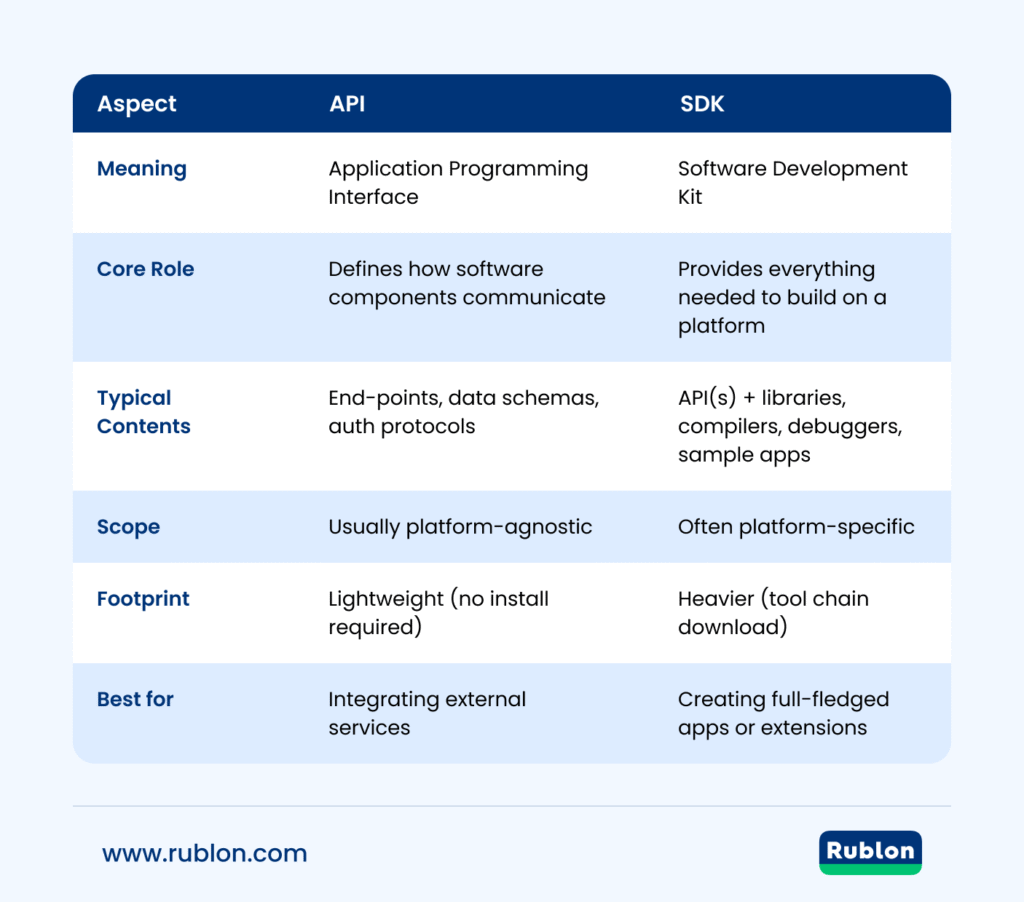APIs (Application Programming Interfaces) and SDKs (Software Development Kits) are two pillars of modern software engineering, but they serve different purposes. An API exposes a clearly defined contract for interacting with existing functionality, while an SDK bundles everything you need (libraries, documentation, tooling, and example code) to create functionality for a given platform.
API vs. SDK: What’s the Difference?
The main difference between an API and an SDK is their purpose and composition. An API is a set of protocols and definitions for building and integrating application software. In contrast, an SDK is a comprehensive toolkit that includes libraries, documentation, and code samples to develop software applications for a specific platform.
But there are many more differences than just that.
Here’s a handy table that outlines the most important differences between APIs and SDKs.
API vs. SDK: Differences Table

| Aspect | API | SDK |
|---|---|---|
| Meaning | Application Programming Interface | Software Development Kit |
| Core Role | Defines how software components communicate | Provides everything needed to build on a platform |
| Typical Contents | End-points, data schemas, auth protocols | API(s) + libraries, compilers, debuggers, sample apps |
| Scope | Usually platform-agnostic | Often platform-specific |
| Footprint | Lightweight (no install required) | Heavier (tool chain download) |
| Best for | Integrating external services | Creating full-fledged apps or extensions |
Practical Examples of APIs and SDKs
To better understand the differences, let’s look at practical examples.
APIs in Action:
- A weather application uses an API to fetch real-time weather data from a weather service.
- Social media platforms provide APIs that allow developers to integrate login or sharing features into their apps.
- Rublon uses APIs like the Rublon Admin API and Rublon REST API.
SDKs in Action:
- The Android SDK allows developers to create Android apps using tools and libraries specific to the Android platform.
- Game developers use the Unreal Engine SDK to build games with advanced graphics and physics.
- Rublon uses SDKs to add robust multi-factor authentication (MFA) to applications written in Java, PHP, and .NET.
Advantages of SDKs over APIs
Here are reasons why an SDK can be a better choice:
- SDKs provide all necessary tools for development, reducing time and effort.
- They include sample code and documentation, simplifying the learning process.
- SDKs offer debugging and testing tools, enhancing code quality.
- They enable seamless integration with the target platform.
Looking for a FIDO MFA Provider?
Protect Active Directory and Entra ID users from hackers with phishing-resistant FIDO security keys and passkeys.
Advantages of APIs over SDKs
Here’s why an API can be preferable:
- APIs enable interaction with existing services without building from scratch.
- They are lightweight and don’t require installing large toolkits.
- APIs offer flexibility across different programming languages.
- They allow integration with third-party services, expanding functionality.
When to Reach for Each
- Choose an API when you need to consume data or behaviour that already exists.
- Choose an SDK when you must build, test, and ship software that targets a specific platform or device.
Conclusion
APIs excel at connecting software; SDKs excel at creating software. Grounding your build-vs-integrate decisions in fresh statistics, real-world case studies, and authoritative standards ensures faster, safer, and more maintainable solutions.
Start Free Rublon MFA Trial Today
Try Rublon MFA free for 30 days
Protect your organization with phishing-resistant MFA authentication, utilizing the Rublon API and Rublon SDKs for different programming languages. Boost your security posture without complexity or cost.
To begin your Free Trial, click the button below.
